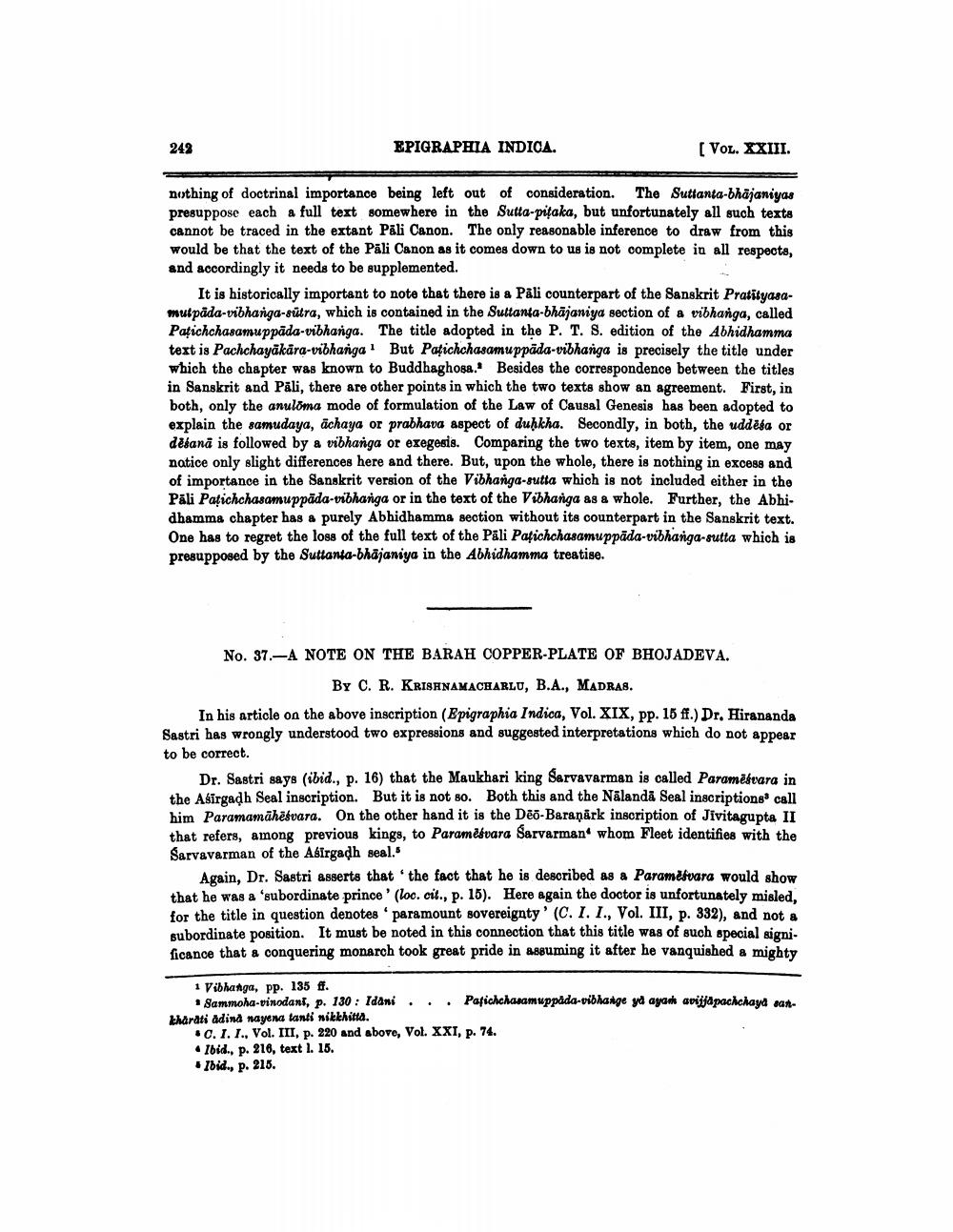________________
242
EPIGRAPHIA INDICA.
[Vol. XXIII.
nothing of doctrinal importance being left out of consideration. The Suttanta-bhajaniyas presuppose each a full text somewhere in the Sutta-pitaka, but unfortunately all such texts cannot be traced in the extant Pāli Canon. The only reasonable inference to draw from this would be that the text of the Pāli Canon as it comes down to us is not complete in all respects, and accordingly it needs to be supplemented.
It is historically important to note that there is a Påli counterpart of the Sanskrit Pratityasamutpäda-vibhanga-sútra, which is contained in the Suttanta-bhājaniya section of a vibhanga, called Pafichchasamuppāda-vibhanga. The title adopted in the P. T. 8. edition of the Abhidhamma text is Pachchayākära-vibhanga! But Pațichchasamuppāda-vibhanga is precisely the title under which the chapter was known to Buddhaghosa. Besides the correspondence between the titles in Sanskrit and Päli, there are other points in which the two texts show an agreement. First, in both, only the anuloma mode of formulation of the Law of Causal Genesis has been adopted to explain the samudaya, achaya or prabhava aspect of duḥkha. Secondly, in both, the uddesa or désana is followed by a vibhanga or exegesis. Comparing the two texts, item by item, one may natice only slight differences here and there. But, upon the whole, there is nothing in excess and of importance in the Sanskrit version of the Vibhanga-sutta which is not included either in the Pali Pațichchasamuppāda-vibhanga or in the text of the Vibhanga as a whole. Further, the Abhidhamma chapter has a purely Abhidhamma section without its counterpart in the Sanskrit text. One has to regret the loss of the full text of the Pali Pafichchasamuppāda-vibhanga-sutta which is presupposed by the Suttanta-bhājaniya in the Abhidhamma treatise.
No. 37.-A NOTE ON THE BARAH COPPER-PLATE OF BHOJADEVA.
BY C. R. KRISHNAMACHARLU, B.A., MADRAS.
In his article on the above inscription (Epigraphia Indica, Vol. XIX, pp. 16 ff.) Dr. Hirananda Sastri has wrongly understood two expressions and suggested interpretations which do not appear to be correct.
Dr. Sastri says (ibid., p. 16) that the Maukhari king Sarvavarman is called Parameswara in the Asirgadh Seal inscription. But it is not so. Both this and the Nalanda Seal inscriptions call him Paramamāhësvara. On the other hand it is the Deo-Baranårk inscription of Jivitagupta II that refers, among previous kings, to Paramèsvara Sarvarman whom Fleet identifies with the Sarvavarman of the Abirgadh seal.
Again, Dr. Sastri asserts that the fact that he is described as a Paramefuara would show that he was a 'subordinate prince' (loc. cit., p. 15). Here again the doctor is unfortunately misled, for the title in question denotes paramount sovereignty' (C. I. I., Vol. III, p. 332), and not a subordinate position. It must be noted in this connection that this title was of such special significance that a conquering monarch took great pride in assuming it after he vanquished a mighty
1 Vibhanga, pp. 135 ff.
Sammoha-vinodant, p. 130 : Idani ... Patichchasamuppåda-vibhange yd ayar avijfpachchaya sankhårdti adind nayena tanti niklehitta.
.0.1. I., Vol. III, p. 220 and above, Vol. XXI, p. 74. • Ibid., p. 216, text I. 15.
Ibid., p. 215.




